Research Article
Soil Evaluation Research for Salton Sea-A Survey of Available Salton Sea Soil and Sediment Evaluation Research Literature
1401
Views & Citations401
Likes & Shares
The Salton Sea, a saline lake in California, is becoming an environmental disaster. With a receding lakeshore, severe dust emission, and toxic water and soil, Salton Sea ecosystem is on a continuous decline for a long time. Many studies and research have been performed to understand the characteristics of soil and sediments present in Salton Sea region to find the root-cause of the environmental degradation and to provide a mechanism to reverse its affects. This survey aims at providing a detailed analysis of the available research literature on Salton Sea soil evaluation and to identify some of the prevalent methods and practices used by researchers. This survey will provide common soil evaluation parameters, collection and analysis methods used by researchers throughout a long duration of continuous research. Finally, this paper will survey some semi-automatic methods for soil analysis and some AI and ML algorithms which are being applied for general soil evaluation.
Keywords: Soil evaluation, Pesticides, Severity level, Chromatography, Spectroscopy, Machine leaning, Artificial intelligence, Support vector machine, Regression
INTRODUCTION
Salton Sea is a 25 x 55 km wide, shrinking saline lake located in southern California. It is surrounded by the agricultural plains of the Imperial Valley in the south, by the Anza-Borrego Desert State Park in the west and by the Coachella Valley on the north. Salton Sea could be categorized as a man-made lake formed during 1905-1907 due to inflows from Colorado river. For a long time, it was the water source and sink for nearby areas. It supported a huge variety of flora and fauna and was also a favorite tourist spot. However, A constant inflow of polluted water from nearby agricultural lands, no drainage outlet and meagre rainfall have converted the lake into an environmental disaster. Now, the beaches are deserted, flora and fauna are nearly extinct, and the odor and insect problems are affecting the nearby areas. Moreover, dust emission from the receding lakebed is contributing to the health problems of local community. The ecology and environment or Salton Sea is under pressure from a long time and there is a need for sustainable solution [1]. Various public and private organizations have performed research and analysis to determine the causes and effects of environmental degradation. Many institutions and agencies have been publishing the research findings even before 1970. The research activities are mostly based on assessing either a specific environmental parameter such as air, water or soil etc. or a combination of these parameters. The conventional evaluation models are based on collecting samples from specific locations, analyzing the samples, and producing results or general findings, to determine the root-cause of the environmental degradation [2]. Physical map of Salton Sea is shown in Figure 1.
Soil is an important parameter which provides a variety of useful information about the environmental condition of any region. Soil quality evaluation is particularly important in case of Salton Sea because the future of adjacent agricultural regions depends fundamentally on a healthy and nutritious soil. However, soil evaluation is complex in nature and wide in scope. For example, Studying the pesticide contents of the soil to understand the effects of agricultural drainage [4] and identifying the physical composition of soil to study erosion [5] employ completely different soil evaluation techniques. Soil can be evaluated using different criteria and methodologies, and a lot of research has already been performed on soil evaluation methods and techniques [6]. Salton Sea soil and sediment evaluation has been performed by different research groups using conventional procedures and techniques. This paper surveys the available research literature to obtain the methods and techniques used for the soil evaluation of Salton Sea region over the period of last fifty years. It is important to note that “soil” is a generic term which also includes variants like sediments, playa etc. and this paper would use these terms interchangeably unless specified otherwise.


Soil can be evaluated using different parameters. Section II will categorize the parameters used by different research papers for Salton Sea soil evaluation. These primary (Level-I) evaluation parameters or indices will be further classified into more complex secondary (Level-II) parameters which are direct indicators of the soil health of any region. This section will also list Salton Sea soil data, for some of the secondary parameters, collected by different researchers. Section III will provide a general survey of data or sample collection methods used for Salton Sea soil evaluation. Section IV will review and compare various sample analysis and detection methods employed by the researchers. Note that Section II, III and IV are specific to Salton Sea soil evaluation and these sections are derived from the Salton Sea based research papers only. Section V will list some industrial equipment which could be used for semi-automatic soil evaluation. It will also provide a table of Artificial Intelligence (AI) and Machine Learning (ML) based algorithms and techniques which are currently used for evaluation of soil throughout the world. It is a general section and it is not limited to Salton Sea. Section V summarizes the findings of this survey and underlines the challenges in moving forward. This survey will end with concluding Section VII.
PARAMETERS FOR SALTON SEA SOIL EVALUATION
Soil evaluation is generally performed by identifying primary parameters and dividing these parameters into secondary parameters. Secondary parameters are directly measured by analysis of the soil sample using a chemical, optical or other type of method. Any primary parameter, however, is calculated indirectly by considering a combination of secondary parameters. Secondary parameters have specific ranges or tolerance limits criteria which are generally established by environmental agencies. For Example, the US EPA (Environmental Protection Agency) determines the heavy metal concentration limits in USA [7]. On the other hand, the primary parameters are just an aggregation of secondary parameters and there are no tolerable numerical limits for primary parameters. Majority of research papers on soil evaluation for Salton Sea use the parameters described in Table 1.

A. Soil Crust Evaluation

A. Soil Crust Evaluation
Soil crust consists of surface layers of the soil which are constantly evolving due to various environmental factors such as rain, storms etc. Soil crust can be divided into three categories [8]:
- Physical crust: - Sand, Silt, Clay
- Biological crust: - Organic matter, micro-organisms etc.
- Chemical crust: - Salt Minerology
For Salton Sea region, study of physical crust provides important information about agricultural suitability such as seed germination, soil moisture content, temperature etc. [9] (Table 2).
Biological crust is made up of organic matter and microorganisms which contributes to the productivity of soil. Chemical crust study provides a deeper understanding of soil erosion and therefore dust emission [5].

B. Nutrients and Minerals Evaluation

B. Nutrients and Minerals Evaluation
Soil consists of a variety of nutrients and minerals which contribute significantly to the health and wellbeing of the soil and environment. A balance of various nutrients like N, P, K are essential for soil fertility and plant growth. A couple of research activities have been performed at different times to access the nutrients and minerals in the soil of Salton Sea region. Table 3 lists some of the nutrients found in the Salton Sea soil [9-13].
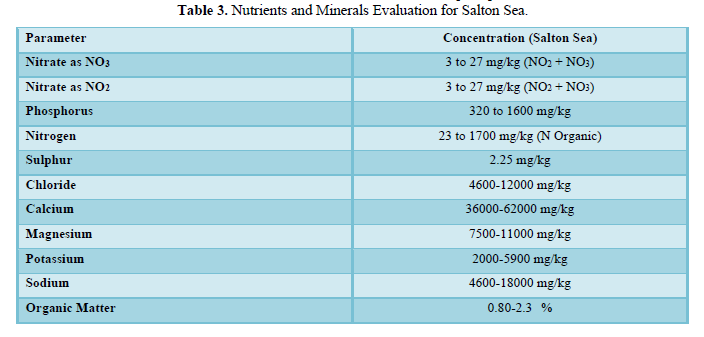
C. Soil Biochemistry Evaluation

C. Soil Biochemistry Evaluation
Soil Biochemistry is a measure of chemical properties of the soil. It could be roughly categorized as a study of chemical reactions and phenomenon in soil. However, a majority of soil biochemistry deals with organic matter content of the soil. Moreover, some studies classify organic matter content as a primary parameter. A limited dataset is available for Salton Sea soil biochemistry analysis (Table 4). Note that there are some other bio-chemistry related parameters, such as Cation Exchange Capacity (CEC), Sodium Absorption Ration (SAR) which are not listed in Table 4. However, the data related to these parameters is not available for Salton Sea.
Note that organic matter concentration and soil moisture changes from one location to another which indicates the differences in regions surrounding the Salton Sea. Also note the high salt content for Salto Sea region [13].

D. Evaluation for Pesticides

D. Evaluation for Pesticides
The parameters discussed above are responsible for soil health and productivity. Now, let us move towards parameters which contribute towards soil toxicity.
One of the most important criteria for soil toxicity evaluation is determining pesticides content in soil. Pesticides are found in almost every landmass adjoining a water body. This is mostly due to the irrigation inflow from nearby agricultural lands. Salton Sea has huge inflow from the irrigation channels of nearby imperial valley and therefore the soil in Salton Sea region contains a variety of pesticides. Pesticides are complex organic and inorganic molecules which have a long and at times complex movement and decomposition cycle. A large quantity of research material is available on Salton Sea soil evaluation for pesticides [10,15,16].
Pesticides can further be divided into various categories depending on the “pest” or “agent.” Some of the categories are:
- Algicide
- Biopesticides
- Fungicides
- Herbicides
- Insecticides
- Rodenticides
Agricultural community use insecticides in large quantities and Table 5 lists some of the insecticides present in Salton Sea soil.


Salton Sea sediments are extensively evaluated for pesticides. It is a definite conclusion that the number of different pesticides is high in the Salton Sea region. Figure 2 provides a chart of p,p’-DDT in sediments collected from various Salton Sea regions over the years as an example [9,15-19].
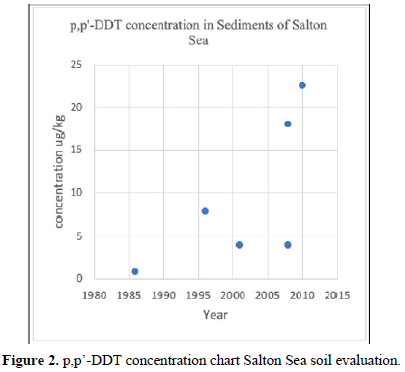
E. Heavy metal and non-metal content

E. Heavy metal and non-metal content
Heavy metals and non-metals also contribute greatly towards soil toxicity. The presence of various heavy metals and non-metals in high quantity is a definite indicator of poisonous soil. This parameter is also largely responsible for making soil barren for any kind of flora and fauna. Salton Sea soil evaluation for heavy metals and non-metals results in very high levels of Selenium and other poisonous metals [20]. Some of the heavy metals and non-metals found in Salton Sea soil are: - Aluminum (Al), Arsenic (As), Barium (Ba), Cadmium (Cd), Cerium (Ce), Chromium (Cr), Cobalt (Co), Copper (Cu), Iron (Fe), Lanthanum (La), Lead (Pb), Lithium (Li), Manganese (Mn), Molybdenum (Mo), Neodymium (Nd), Nickel (Ni), Niobium (Nb), Selenium (Se), Silver (Ag), Strontium (Sr), Thallium (Tl), Thorium (Th), Titanium (Ti), Uranium (U), Vanadium (V), Zinc (Zn) (Table 6).
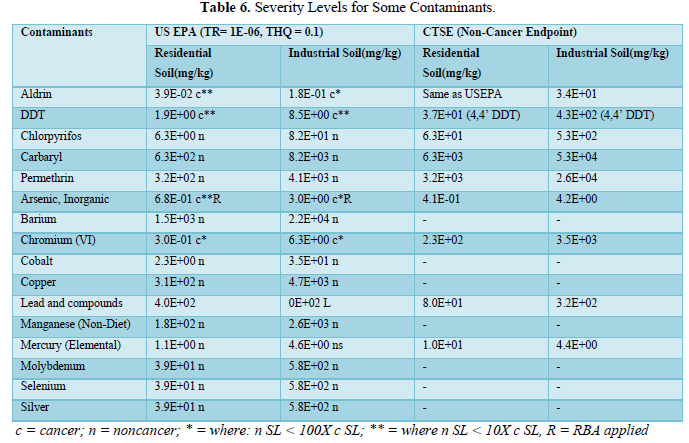

United States Environmental Protection Agency (US EPA) provides guidance about screening levels (Regional Screening Levels) of various chemical contaminants in the soil from cancer and non-cancer end points. It provides the generic RSL tables and guidance about equations to calculate the various types of chemical risks associated with a chemical contaminant to various entities like residents, workers etc. [7]. California EPA and DTSC (Department of Toxic Substance Control) also provides the screening levels of various chemical contaminants from cancer and non-cancer end points [21]. These two datasets are often used for identifying the maximum limits for soil contaminant evaluation. Table 6 provides generic RSLs for some of the toxic soil parameters.
METHODS USED FOR SOIL SAMPLE COLLECTION
A major aspect of soil evaluation is sample collection. It is difficult to perform soil evaluation using remote sensing techniques. However, there are some remote sensing techniques to predict limited soil parameters such as soil moisture [22]. For Salton Sea, majority of sample collection methods were manual in nature. Table 7 summarizes the details of methods used for sample collection by different researchers for soil evaluation.
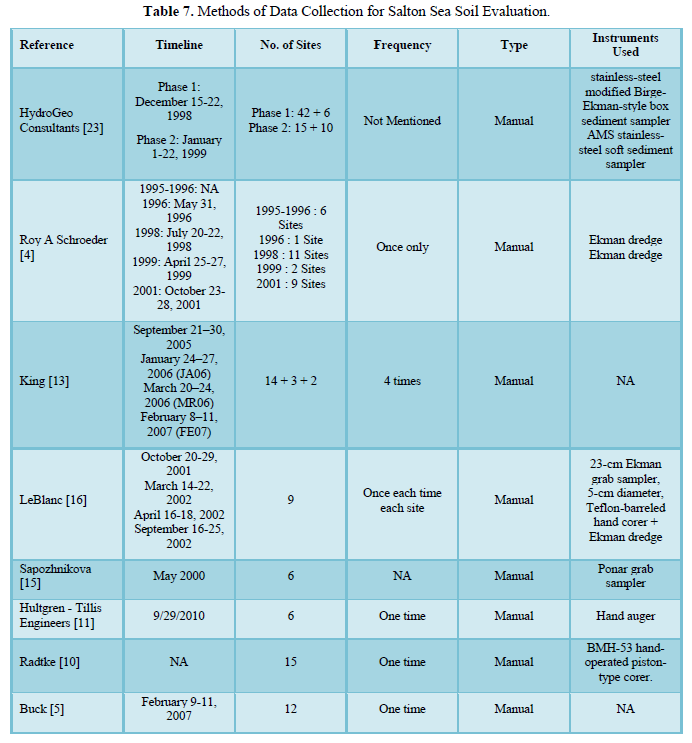

METHODS FOR SAMPLE ANALYSIS
The final aspect of soil evaluation is the analysis of soil sample collected in the field. Analysis of sample to determine the concentration of different parameters is normally performed by using one of the standard chemical analysis methods listed here.
- Ion Chromatography (IC)
Ion Chromatography is a prevalent chemical analysis method which is capable of detecting almost any charged molecule including large proteins, small nucleotides, and amino acids. It works via separation and quantitative analysis of anions and cations in an ionic solution using the ion exchange method of liquid chromatography (LC).
- Gas Chromatography (GC)
Chemical analysis method which is applicable to any compound that can be vaporized without decomposition (like NO3, NO2, P, N etc.). The components of a sample are dissolved in a solvent and vaporized in order to separate the analytes by distributing the sample between two phases: a stationary phase and a mobile phase. The mobile phase is a chemically inert gas that serves to carry the molecules of the analyte through the heated column.
- Inductively Coupled Plasma Atomic Emission Spectroscopy (ICP-AES)
ICP-AES is a chemical analysis method used for determining trace elements, including metals, in solutions. All matrices including ground water, aqueous samples, TCLP and EP extracts, industrial and organic wastes, soils, sludges, sediments, and other solid wastes, require digestion prior to analysis. The ICP-AES is composed of two parts: the ICP and the optical spectrometer. Every ICP has a source, or plasma, optics to split the light into its various wavelengths, and a detector to measure each specific wavelength and its intensity. The position of the light on the detector determines its wavelength and the intensity is proportional to concentration.
- Inductively Coupled Plasma Mass Spectroscopy (ICP-MS)
ICP-MS is a chemical Analysis method used for metals and non-metals detections. It can also detect isotopes. It works via atomizing the sample and creating atomic and small polyatomic ions, which are then detected.
- Energy Dispersive X-Ray Fluoroscence Spectroscopy (ED-XRF)
It is an X-Ray based analysis method capable of detecting all the elements. This type of XRF instrumentation separates the characteristic x-rays of different elements into a complete fluorescence energy spectrum which is then processed for qualitative or quantitative analysis (Table 8).
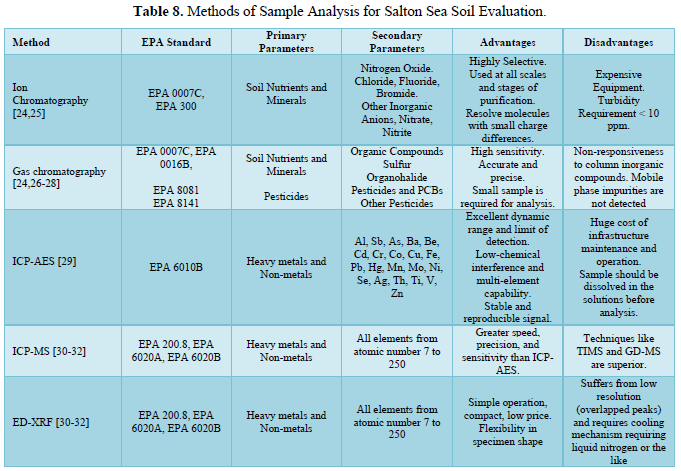

- Other methods
These are some other methods found in the research literature for Salton Sea soil sample analysis. These methods are specially used for soil crust and biochemistry evaluation (Table 9).


Automatic Approaches for Soil Evaluation
This section provides a general description about some “automatic” approaches which could be used to automate the soil evaluation process. These approaches are not taken from research literature for Salton Sea soil evaluation. This is an exploratory section which is applicable to any kind of soil evaluation including Salton Sea soil evaluation. The data and methods described in this section are general in nature and these approaches could be used to partly automate the soil evaluation practices.
- Automatic parameter evaluation instruments
There are some commercially available instruments which could be used to evaluate some of the parameters of the soil. Table 10 provides a list of some such instruments.
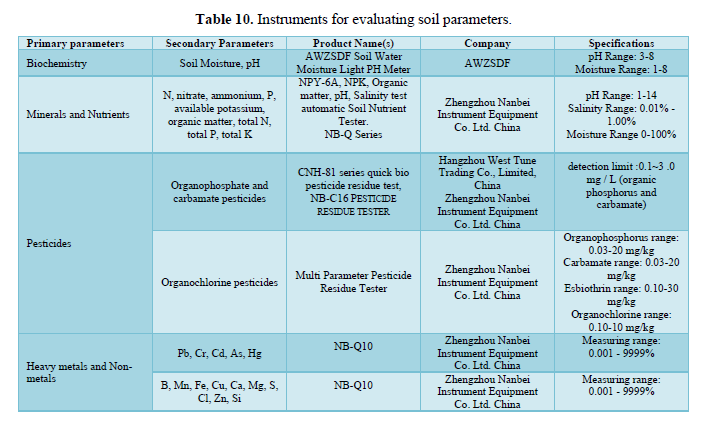 2. Machine Learning based evaluation Methods
2. Machine Learning based evaluation Methods
 2. Machine Learning based evaluation Methods
2. Machine Learning based evaluation MethodsMost of the research literature for general soil evaluation follow traditional methods as described earlier. However, to some extent, some Machine learning and artificial intelligence algorithms could be successfully applied to automate the process of soil evaluation. It is important to note that soil evaluation using AI and ML techniques is still an active area of research. In fact, one of the interesting findings of this survey is that no AI and ML based technique is applied on Salton Sea soil evaluation.
Table 11 is compiled from the study of available soil evolution research which use AI and ML for soil sample analysis. In all cases, AI and ML algorithms are used with an existing method to obtain tangible results.
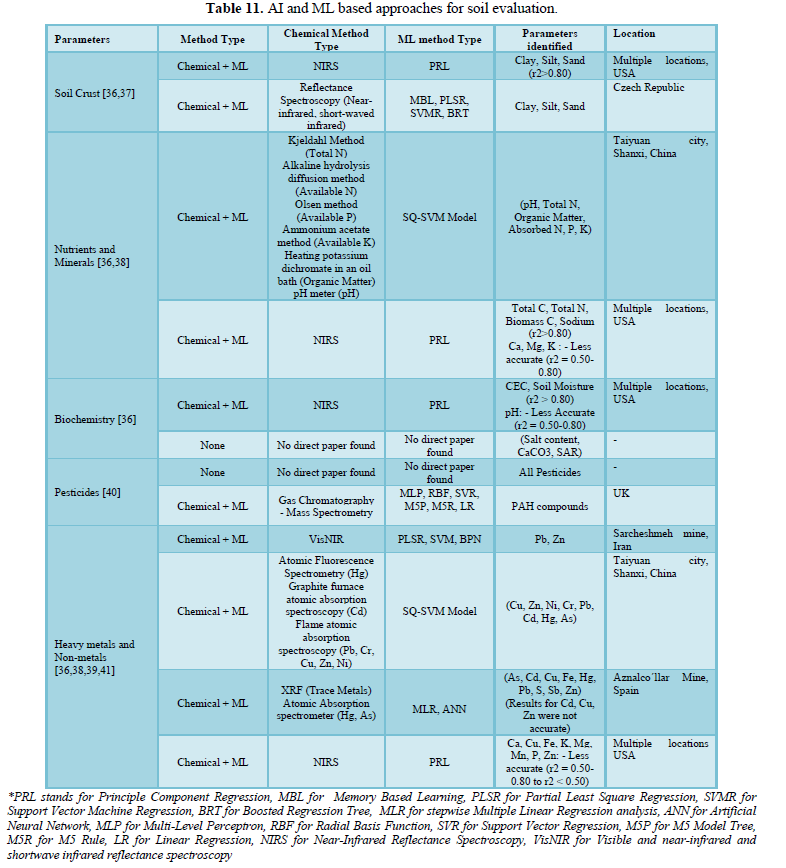

ISSUES, NEEDS AND CHALLENGES
Some of the issues discovered by this survey and the respective needs are listed below.
- Issue#1: Most of the traditional methods used for soil evaluation of Salton Sea are manual in nature. Traditionally, soil evaluation is a laborious task which is highly dependent on manual efforts such as sample collection, laboratory test etc. All these factors make soil evaluation an arduous, time consuming task.
- Need#1: Transition towards semi-automatic and automatic methods for analysis. There is a strong need to perform soil analysis using modern automatic analysis techniques which will reduce the time and produce results swiftly.
- Finding#2: High reliance on chemical analysis is observed. There are limited evaluation methods which could be used as an alternative. One exception was soil moisture evaluation where satellite-based methods are used for Salton Sea [22].
- Need#2: Alternative approaches should be used for some parameters. Though it is difficult to analyze soil without using chemical methods, yet it is important to employ alternative methods for the analysis of several simple parameters like soil moisture. It is also desirable to derive some alternate methods based on modern AI and ML techniques which could simplify the process.
- Finding#3: There is a high degree of variance between different research data. Various researchers have collected the data using different techniques and methods over a large period of time. Therefore, big differences are observed for some parameter’s values in different studies.
- Need#3: There is a need for comprehensive model which could be used uniformly and provide low variance. A standardized framework will provide options to collect data in a uniform manner. It will also allow reuse of the data for a variety of analysis.
- Finding#4: Limited use of AI and ML techniques for Soil evaluation of Salton Sea. No research literature mentions applying AI and ML techniques to Salton Sea soil evaluation.
- Need#4: AI and ML based techniques should be implemented for soil evaluation of Salton Sea. This will result in a major improvement over almost all the aspects of traditional soil evaluation. It will reduce the time and effort and will also enable researchers to perform predictive analysis to identify the fragile parameters in Salton Sea soil.
Soil evaluation is a challenging subject. Most of the process is manual which makes soil evaluation even less feasible than evaluation of other environmental parameters. It could be concluded that the overall process cannot be transformed into a totally automatic one, at least without significant research and development. There are some major repercussions of this limitation. Being manual, the process is time consuming, and as a result, it could not be performed repeatedly without considerable efforts. This results in either non-availability of data or obsolete data for comparative analysis. Other challenge is managing the financial aspect of the process. The instruments which can perform the tests are expensive and usually require expert support. As discussed throughout the paper, soil analysis can be performed using different instruments and techniques. A subtler challenge is to convince the researchers to follow a standard set of procedures and techniques to make data more reusable.
CONCLUSION
Salton Sea is California’s largest lake. It has been a lifeline of local communities and a wide variety of flora and fauna for more than 100 years. Its survival is crucial for the success and prosperity of the region. Therefore, an improved and focused approach is required to reverse environmental degradation of the Salton Sea. A better understanding of various environmental parameters is essential to fulfill this mission. This work has identified the traditional methods of evaluation of one such environmental parameter – soil. This paper has surveyed the available research literature to obtain a comprehensive understanding of methods and techniques used for Salton Sea soil and sediment evaluation. Most importantly, it has retrieved a general set of primary and secondary parameters used for Salton Sea soil evaluation by various researchers. This paper has also provided a comprehensive set of data collection and data analysis methods used for Salton Sea soil evaluation. Finally, modern soil evaluation methods using AI and ML, which attempt to solve the problem using a completely different approach, are presented. Major findings and challenges are also highlighted separately.
- The Washington Post, “The fate of the Salton Sea”. Accessed on June 8, 2019. Available online at: https://www.washingtonpost.com/national/the-fate-of-the-salton-sea/2015/05/28/91e2029c-0574-11e5-a428-c984eb077d4e_gallery.html
- Kaur G, Gao J, Chiao S, Lu S, Xie G (2018) Air Quality Prediction: Big Data and Machine Learning Approaches. Int J Environ Sci Dev 9(1): 8-16.
- Rossiter DG (1990) ALES: A framework for land evaluation using a microcomputer. Soil Use Manag 6(1): 7-20.
- Schroeder RA (2004) Chemical Data for Detailed Studies of Irrigation Drainage in the Salton Sea Area, California, 1995-2001. Scientific Investigations Report, 2004.
- Buck B, King J, Etyemezian V (2011) Effects of Salt Mineralogy on Dust Emissions, Salton Sea, California. Soil Sci Soc Am J 75(5): 1971.
- Rowell D (2014) Soil science: Methods & applications. pp: 368.
- United States Environmental Protection Agency. Regional Screening Levels for Chemical Contaminants at Superfund Sites. Accessed on: September 9, 2019. Available online at: https://www.epa.gov/risk/regional-screening-levels-rsls
- Pagliai M, Stoops G (2010) Physical and biological surface crusts and seals. Interpretation of micromorphological features of soils and regoliths. pp: 419-440.
- Miles AK, Ricca MA, Meckstroth A, Spring SE (2009) Salton Sea Ecosystem Monitoring Project. Open-File Report. Available online at: https://pubs.usgs.gov/of/2009/1276/pdf/ofr20091276.pdf
- Radtke DB, Kepner W, Effertz R (1998) Reconnaissance Investigation of Water Quality, Bottom Sediment, and Biota Associated with Irrigation Drainage in the Lower Colorado River Valley, Arizona, California, and Nevada, 1986-1987. Available online at: https://pubs.usgs.gov/wri/1988/4002/report.pdf
- Preliminary Geotechnical Investigation Salton Sea Species Conservation Habitat Project Salton Sea, California, Project No. 758.01, Prepared by Hultgren - Tillis Engineers. Accessed on: September 2, 2011.
- Stuart HH (2008) The Salton Sea Centennial Symposium: Proceedings of a Symposium Celebrating a Century of Symbiosis Among Agriculture, Wildlife and People, 1905–2005, held in San Diego, California, USA, March 2005.
- King J, Etyemezian V, Sweeney M, Buck BJ, Nikolich G (2011) Dust emission variability at the Salton Sea, California, USA. Aeolian Res 3(1): 67-69.
- Goldstein HL, Breit GN, Yount JC, Reynolds RL, Reheis MC, Skipp GL, Fisher EM, Lamothe PJ (2011) Physical, chemical, and mineralogical data from surficial deposits, groundwater levels, and water composition in the area of Franklin Lake playa and Ash Meadows, California and Nevada. Data Series, pp. i-153. Available online at: https://pubs.usgs.gov/ds/607/ds607.pdf
- Sapozhnikova Y, Bawardi O, Schlenk D (2004) Pesticides and PCBs in sediments and fish from the Salton Sea, California, USA. Chemosphere 55(6): 797-809.
- Leblanc LA, Kuivila KM (2008) Occurrence, distribution and transport of pesticides into the Salton Sea Basin, California, 2001-2002. The Salton Sea Centennial Symposium. Int. J. of Aquatic Science 604: 151-172.
- Ross K, Ohlendorf H (2008) Summary Evaluation of Selenium and Organochlorine Pesticide Concentrations at IID Managed Marsh Site. Accessed on: September 8, 2019. Available online at: https://www.iid.com/home/showdocument?id=2306
- ca.gov. (2014) Final report evaluation of sediment, water and fish tissue for contaminant levels in the Salton Sea and its two primary tributaries, the Alamo river and New river from 2001-2012. Accessed on: September 8, 2019. Available online at: https://www.waterboards.ca.gov/water_issues/programs/swamp/docs/reglrpts/ss_fnl_eval.pdf
- usgs.gov. (2013) Salton Sea Ecosystem Monitoring and Assessment Plan. Accessed on: September 8, 2019. Available online at: https://pubs.usgs.gov/of/2013/1133/pdf/ofr20131133.pdf
- Frie AL, Dingle JH, Ying SC, Bahreini R (2017) The Effect of a Receding Saline Lake (The Salton Sea) on Airborne Particulate Matter Composition. Environ Sci Technol 51(15): 8283-8292.
- Department of Toxic Substance Control (2019) Human Health Risk Assessment Note 3 - DTSC-Modified Screening Levels (DTSC-SLs). Accessed on: September 8, 2019. Available online at: https://dtsc.ca.gov/wp-content/uploads/sites/31/2019/04/HHRA-Note-3-June-2020-A.pdf
- Chan SK, Bindlish R, O’Neill PE, Njoku E, Jackson T, et al. (2016) Assessment of the SMAP passive soil moisture product. IEEE Trans Geosci Remote Sens 54.8: 4994-5007.
- California State Water Resources Control Board Hearing Regarding Salton Sea, Testimony of Richard A. Vogl, Principal Hydrogeologist, HydroGeo Consultants, 2002. Available online at: https://www.waterboards.ca.gov/waterrights/water_issues/programs/hearings/iid_sdcwa/pcl/exhibits/pcl_28.pdf
- EPA Method 7C - Nitrogen Oxide - Colorimetric Method (2017) Method 7C Determination of Nitrogen Oxide Emissions from Stationary Sources (Alkaline Permanganate/Colorimetric Method) Accessed on: September 8, 2019. Available online at: https://www.epa.gov/sites/production/files/2017-08/documents/method_7c.pdf
- Pfaff JD, Brockhoff CA, O'Dell JW (1993) EPA Method 300.0. Determination of inorganic anions by ion chromatography. Revision 2 (1993). Available online at: https://www.epa.gov/sites/production/files/2015-08/documents/method_300-0_rev_2-1_1993.pdf
- EPA Method 16B - Total Reduced Sulfur - Gas chromatograph Analysis (2017) Method 16B Determination of Total Reduced Sulfur Emissions from Stationary Sources. Accessed on September 8, 2019. Available online at: https://19january2017snapshot.epa.gov/sites/production/files/2016-06/documents/m-16b.pdf
- US Environmental Protection Agency (US EPA) (2007) Organochlorine Pesticides by Gas Chromatography, Method 8081B. Available online at: https://www.epa.gov/sites/production/files/2015-12/documents/8081b.pdf
- Pesticides, Organophosphorus (2007) Method 8141B organophosphorus compounds by Gas Chromatography. Available online at: https://www.epa.gov/sites/production/files/2015-12/documents/8141b.pdf
- USEPA (US Environmental Protection Agency) (2007) Method 6010B: Inductively coupled plasma-atomic emission spectrometry, physical/chemical methods SW846. Available online at: https://www.epa.gov/sites/production/files/documents/6010b.pdf
- US EPA (1994) Method 200.8: Determination of Trace Elements in Waters and Wastes by Inductively Coupled Plasma-Mass Spectrometry. Revision 5.4. Available online at: https://www.epa.gov/sites/production/files/2015-08/documents/method_200-8_rev_5-4_1994.pdf
- US Environmental Protection Agency (1994) Method 6020A: Inductively coupled plasma‐mass spectrometry. Test Methods for Evaluating Solid Waste. Available online at: http://edgeanalytical.com/wp-content/uploads/Inorganic_6020A.pdf
- US Environmental Protection Agency (2014) Method SW 6020B: Inductively Coupled Plasma Mass Spectrometry. Avaialbel online at: https://www.epa.gov/sites/production/files/2015-12/documents/6020b.pdf
- Soukup DA, Drees LA, Lynn WC, Ulery AL, Drees LR (2008) Sampling Soils for Mineralogical Analyses,” SSSA Book Series Methods of Soil Analysis Part 5-Mineralogical Methods, 2008.
- Ben‐Dor E, Banin A (1989) Determination of organic matter content in arid‐zone soils using a simple ‘loss‐on‐ignition’ method. Commun Soil Sci Plan Anal 20(15-16): 1675-1695.
- Sparks D, Page A, Helmke P, Loeppert R, Sumner ME, Miller WP (1996) Cation Exchange Capacity and Exchange Coefficients. SSSA Book Series Methods of Soil Analysis Part 3-Chemical Methods, 1996.
- Chang CW, Laird DW, Mausbach MJ, Hurburgh CR (2001) Near-infrared reflectance spectroscopy-principal components regression analyses of soil properties. Soil Sci Soc Am J 65(2): 480-490.
- Gholizadeh A, Borůvka L, Saberioon M, Vašát R (2016) A memory-based learning approach as compared to other data mining algorithms for the prediction of soil texture using diffuse reflectance spectra. Remote Sens 8(4): 341.
- Yong L, Huifeng W, Hong Z, Karsten L (2016) A comprehensive support vector machine-based classification model for soil quality assessment. Soil Till Res 155: 19-26.
- Khosravi V, Ardejani FD, Yousefi S, Aryafar A (2018) Monitoring soil lead and zinc contents via combination of spectroscopy with extreme learning machine and other data mining methods. Geoderma, 318: 29-41.
- Wu G, Kechavarzi C, Li X, Wu S, Pollard SJT, et al. (2013) Machine learning models for predicting PAHs bioavailability in compost amended soils. Chem Eng J 223: 747-754.
- Kemper T, Sommer S (2002) Estimate of Heavy Metal Contamination in Soils after a Mining Accident Using Reflectance Spectroscopy. Environ Sci Technol 36(12): 2742-2747.
QUICK LINKS
- SUBMIT MANUSCRIPT
- RECOMMEND THE JOURNAL
-
SUBSCRIBE FOR ALERTS
RELATED JOURNALS
- Journal of Veterinary and Marine Sciences (ISSN: 2689-7830)
- Journal of Genomic Medicine and Pharmacogenomics (ISSN:2474-4670)
- Journal of Astronomy and Space Research
- Proteomics and Bioinformatics (ISSN:2641-7561)
- Journal of Microbiology and Microbial Infections (ISSN: 2689-7660)
- Journal of Genetics and Cell Biology (ISSN:2639-3360)
- Advances in Nanomedicine and Nanotechnology Research (ISSN: 2688-5476)



